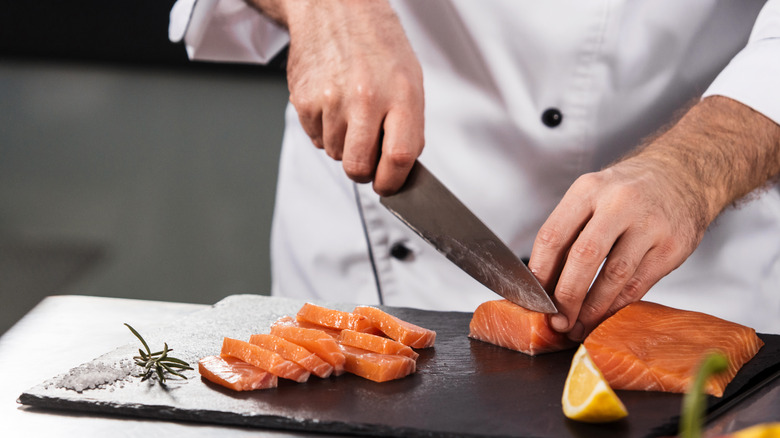Daniel Boulud's Important Tip For Cutting Delicate Foods
There's nothing more disheartening than taking a poor tomato, that never hurt anybody, and demolishing it into a crimson mess reminiscent of a crime scene. It can be hard for some of us to get the perfect slices of more delicate foods like tomatoes, fish, or fresh cheeses without simultaneously crushing them into a pulp. It might just make for a bad presentation sometimes, but other times it can affect how items cook or mix with other foods. You'll want nice clean cubes of tomato to top your bruschetta for example.
Thankfully, world famous chef Daniel Boulud has a tip to help the up-and-coming cook to slice and dice even the most delicate of foods like a professional. Boulud, who is originally from Lyon, is the owner of nearly a dozen New York City-based restaurants, including his two Michelin star rated flagship Daniel. He also has restaurants in Miami, Dubai, Montreal, and Toronto, among other great cities around the globe.
He recently hosted an SPG/Marriott Rewards Moment experience dinner where he shared some of his kitchen wisdom with guests like Reader's Digest writer Melissa Klurman.
Don't murder the fish
When it comes to properly slicing delicate foods, Boulud says that the most important thing is to have a sharp knife (via Reader's Digest). He says that having a well honed blade allows you to cut through those delicate items without pushing down, and crushing them. Instead, simply slide the razor sharp blade across the surface of the food, and let the knife do the work. Or, as he so gently put it during his SPG/Marriott Rewards Moment experience, "Don't murder the fish!'" Using a soft, slanted stroke with a sharp knife will save you a mess to clean up in the kitchen, and save your dinner from looking like it was cut with a chainsaw.
Another great method for cutting delicate items that require a softer touch is the Chiffonade technique, per Buzzfeed. This technique is most often used for green leafy vegetables, and especially herbs that require a softer touch to properly express their flavors and aromas. The method is performed by keeping the tip of the knife pressed onto the cutting surface while lifting the other end up a couple of inches (via Serious Eats). Then, pull the knife toward you, and across a thin section of your food to produce small strips. This method allows you to slice the food instead of chop it, and maintain more of its crisp structure.

